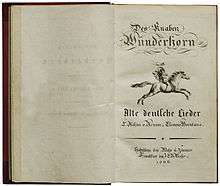Des Knaben Wunderhorn

.jpg)
_Des_Knaben_Wunderhorn.jpg)
Des Knaben Wunderhorn: Alte deutsche Lieder (German; "The boy's magic horn: old German songs") is a collection of German folk poems and songs edited by Achim von Arnim and Clemens Brentano, and published in Heidelberg, Baden. The book was published in three editions: the first in 1805 followed by two more volumes in 1808.
The collection of love, soldier's, wandering and children's songs was an important source of idealized folklore in the Romantic nationalism of the 19th century. Des Knaben Wunderhorn became widely popular across the German-speaking world; Goethe, one of the most influential writers of the time, declared that Des Knaben Wunderhorn "has its place in every household".
Cultural-historical background
Arnim and Brentano, like other early 19th-century song collectors, such as the Englishman Thomas Percy, freely modified the poems in their collection. The editors, both poets themselves, invented some of their own poems. Some poems were modified to fit poetic meter, to conform to then-modern German spelling, or otherwise to conform more closely to an idealized, Romantic "folk style" (Naturpoesie). A 20th-century critical edition by Heinz Rölleke describes the origin of each poem in the collection.[1] Brentano was motivated more by writing his own material than by a strict preservation of the original folk songs.
The young proponents of Romanticism, strongly taken by national sentiments, devoted themselves to the collection and study of the origins of Germanic history in folk songs, fairy-tales, myths, sagas (Nibelung), and Germanic literature. Everything untouched by the negative effects of modern civilization in their eyes, was considered good and helpful for the "Gesundung der Nation" (Recovery of the nation). It was under Brentano's direction that the Brothers Grimm began collecting their fairytales.
Des Knaben Wunderhorn in music
Selected poems from this collection have been set to music (Lieder) by a number of composers, including Weber, Loewe, Mendelssohn, Schumann, Brahms, Zemlinsky, Schoenberg, and Webern.
Gustav Mahler numbered the collection among his favourite books and set its poems to music throughout much of his life. The text of the first of his four Lieder eines fahrenden Gesellen, begun in 1884, is based on the Wunderhorn poem Wenn mein Schatz. Between 1887 and 1901, he wrote two dozen settings of Wunderhorn texts, several of which were incorporated into (or composed as movements for) his Second, Third and Fourth symphonies. In 1899, he published a collection of a dozen Wunderhorn settings that has since become known, slightly confusingly, simply as “Songs from ‘Des Knaben Wunderhorn.’”
References
- ↑ von Arnim, Achim; Brentano, Clemens (1987), Rölleke, Heinz, ed., Des Knaben Wunderhorn, Stuttgart: Reclam
Further reading
- Carpenter, Humphrey and Mari Prichard (1984). The Oxford Companion to Children's Literature. New York: Oxford University Press. ISBN 0-19-211582-0
External links
| Wikimedia Commons has media related to Des Knaben Wunderhorn. |